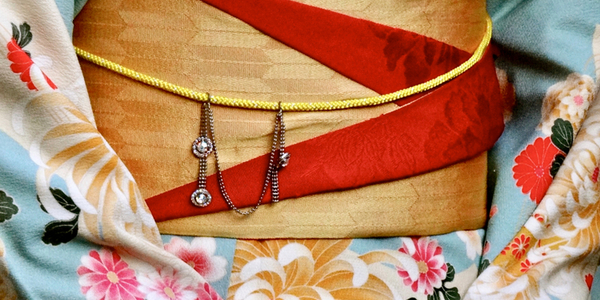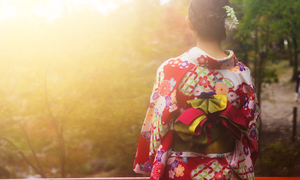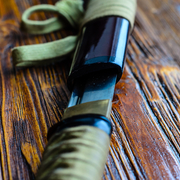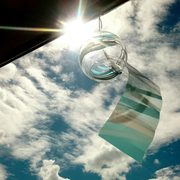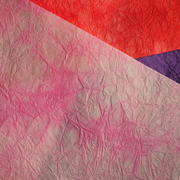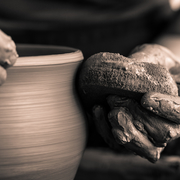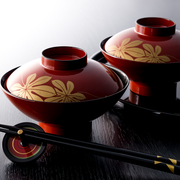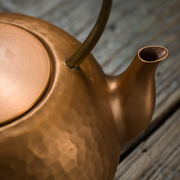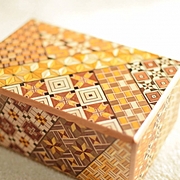Japanese traditional Kimono is also called as “Wafuku” and was originated in the Nara and the Heian period (Nara:710-794 , Heian:794-1192).
In those days, “Kosode”, the original form of Japanese Kimono, was introduced and popular among female aristocrats.
Eventually, they enjoyed coloring and own wearing as fashion, which created the culture of “Juni-hitoe”, which refers to wear several Kosode together uniquely in Japan.
The appearance of “Juni-hitoe” by Sei Shonagon and Murasaki Shikibu, who are known as female writers in the Heian period, may be familiar, but we cannot help feeling impressed with the strength and beauty of women brave and elegant.

According to “Genji Monogatari Emaki”, drawn in the end of the Heian period, Juni-hitoe spread as Shozoku (a formal wear) of female aristocrats.
Yet, it has not been found out how women wore in the middle of the Heian period.
In the late of the Heian period, due to the belief at that time, the trend which denied the female appearance with gorgeous “Juni-hitoe” in public made “Juni-hitoe” declined naturally.
Then, “Juni-hitoe” became limited to “Itsutsu-ginu” referring to 5 layered Kimono.
In the Meiji period(1868-1912), European (Western) culture was introduced and western clothing also got popular.
Then, “Kimono” came to be called as “Wa (Japanese) no Fuku (clothing)” = ”Wafuku”.
Get to know “Some”, “Ori” and “Kakushiki” before wearing Kimono
Kimono has 2 styles of “Some” and “Ori”.
It is not exaggerated to say that the differences between these 2 and combining them decide its “Kakushiki (formality)” and TPO (manners of Wafuku).
The representatives of Kimono are “Kuro Tome-sode” and “Furi-sode”.
K uro Tome-sode as a formal Kimono for Married women (Kimono at Celebrating events)
Kuro tome-sode is a formal Kimono for married women at celebrating events, which has 5 “Hinata-mon” undyed on in its black field.
Kuro tome-sode is a gorgeous Kimono decorated only on the sleeves with brilliant Eba-pattern, which is currently worn by mothers of the bride and the groom at the wedding.
The fabric of textile used for Kuro tome-sode is called as “Hitokoshi Chirimen”, which is the high-quality fabric with small “Shibo (grains)”.
Tango Chirimen in Kyoto is well-known among them.
“Shibo” means concavity and convexity appeared on the fabric of Chirimen.
This concavity and convexity appear on the surface by process of weaving to the left and the right alternately using Kyonen-shi hard twisted as the weft to the warp.
Chirimen fabric’s “Shibo” makes the textile more flexible, which makes it dry not to stick to the skin in summer, and makes the layer of air to keep warm in winter.
The typical pattern on Kuro tome-sode sleeves are graceful “Kissyo Monyo”, “Yusoku Monyo” and “Shosoin Monyo”.
Using Fukuro-obi (double-woven Obi) like “Nishiki-ori” or “Kara-ori” in gold, silver and white creates perfect style on Some, Ori and Kakushiki.
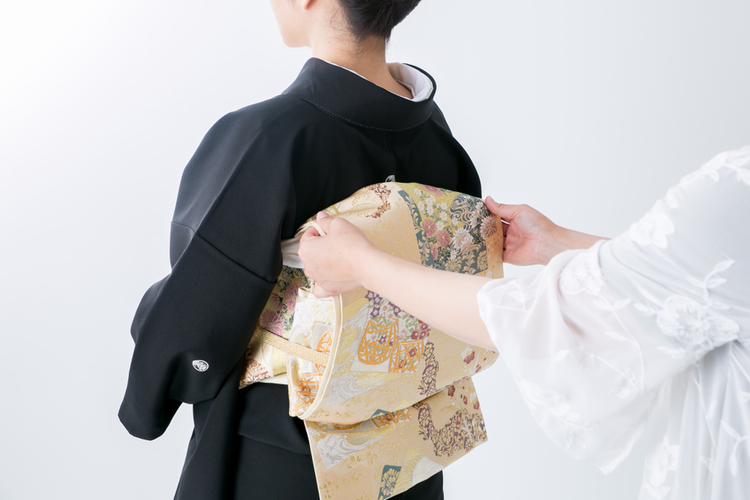
W hat is Iro tome-sode?
Tome-sode has the style of Iro tome-sode.
Nowadays, for example, Iro tome-sode is worn by celebrities invited to attend at the tea parties held at the Imperial Palace.
As for the formality, it can have 5 crests same as Kuro tome-sode, but normally it has only 1 crest, which can be worn by unmarried women.
It is important to know that Kuro tome-sode with 5 crests is the highest class of Kimono, which should be worn by a person who invites guests.
On the other hand, Iro tome-sode is for the invited ones.
F uri-sode as a formal Kimono for Unmarried women
Furi-sode is a formal Kimono for unmarried women and creates graceful and beautiful style.
The length of sleeves of Furi-sode symbolizes the youth.
The longer it is, the more elegant it becomes.
There are many styles of Furi-sode and its length; 125cm for O-Furi-sode, 87-106cm for Furi-sode, and 76-86cm for Ko-Furi-sode.
The fabric used for Furi-sode are fine Hitoko-Chirimen, Rinzu-Chirimen, or Donsu-Chirimen.
Hitoko-Chirimen has been mentioned above, so let’s see the brief details about Rinzu-Chirimen and Donsu-Chirimen.
Rinzu-Chirimen is woven with Kyonen-shi hard twisted as the weft to the warp.
Compared with normal Rinzu, it is softer and thicker fabric with Shibo to get dyed later.
On the other hand, Donsu is well known for “Kinran Donsu”, which is thick and heavy Sakizome textile with patterns woven with previously dyed weft and warp.
However, “Donsu-Chirimen Kiji” used for Furi-sode is flexible white fabric to be dyed later.
Both fabrics are fine and high-class, and the fresh and colorful base of Furi-sode is dyed with various patterns called “Koten Moyo”, “Shibori-zome”, modern-arranged “Yuzen Moyo” or “Tobi-gara”.

Charms of Kimono: Fashion for All Women
As time goes by, a conventional lifestyle has changed drastically, and the opportunities to wear Kimono has declined.
Yet, at the traditional “Omiya Mairi” after a month since a baby is born, at celebrating “Shichi-Go-San”, at celebrating the age of 20 “Seijin Shiki”, at the New Year, we still have customs to wear Kimono.
Charms of Kimono is that its size can be changed freely on wearing by the technique of “Ohashori”※ for the short with the short and the tall with the long because Kimono is sewn with additional length.
※ Ohashori: To raise and fold the extra length at the waist to tie with Koshi-himo
Recently, there are many foreign women in Kimono.
This shows many people from different countries can enjoy Kimono by handling “Ohashori” and Obi well without worrying about the length.
The collar decides the style of Kimono.
Wearing Kimono properly makes anyone feel elegant and attractive, then makes even the facial expressions beautiful.
Modern Kimono: “Fashion with Your own style”
Thinking about “the modern Kimono culture”, it can be said that it is the very time when a new Kimono culture is about to start.
As for the Kimono industry, one of the Kimono shops in Kyoto said, “we have been working on creating good Kimono, but now found no one to wear them.”
These words mean decreasing of Kimono wearers, which must have huge impacts on its industry.
Many of those who attend the Kitsuke class and enjoy Kimono said that they didn’t buy expensive Kimono for special life events, but rent it or wore dresses.
In short, nowadays, few people have the full set of Kimono like Kuro tome-sode, Homon-gi and Tsukesage (semi-formal), Komon (Kimono with fine pattern), Tsumugi (pongee) and accompanied goods like a coat, Obi, accessories along with various occasions.
Modern people enjoy Kimono combining the different styles such as good old and rhetoric Kimono with different Obi and accessories, or changing the collar color of Naga Juban.
Creating your own style seems to be the mainstream of the modern “Kimono culture”.
“I love Kimono because I can enjoy my own style in Kimono more than in dresses.”
The genuine joy of wearing Kimono comes from those words, which lighten the future of Kimono.
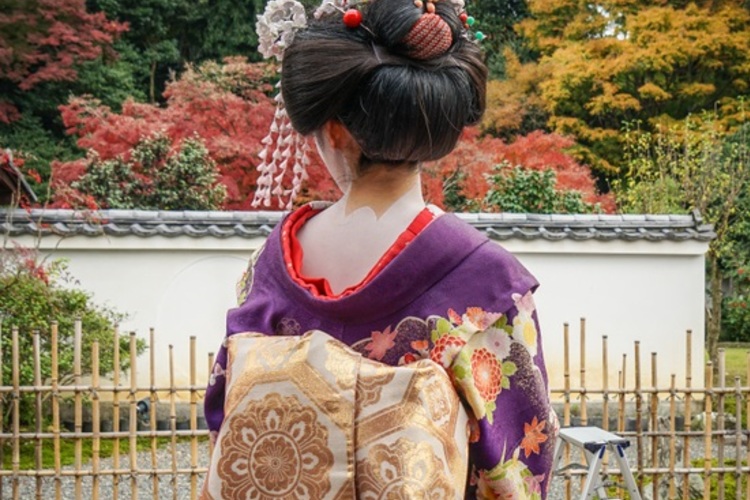
Conclusion
You may think that it is hard to choose the right one among traditional Kimono on each occasion.
However, as for the formality,
Casual clothing = Tsumugi Kimono.
Casual dress = Komon Kimono.
Party dress = Furi-sode (Unmarried) or Homongi.
Those classifications will help you to see what to wear.
For the question “What should I have as the first Kimono?”, the answer will be Kimono of “Edo Komon” or “Tobigara Komon”, which is easy to handle.
As “Edo Komon” is the higher class among the Komon Kimono, you can wear it on various occasions where you normally wear a casual dress such as date, the New Year, or dinner party with friends.
As for Obi, it is good to use Nagoya-obi of Ori or Obi of Some for Fukuro-obi (double-woven).
Different colors of Obi, or accessories like Obi-age changes the impression of Kimono completely.
Please enjoy various coordinationc of Kimono.

